All animals are members of the Kingdom Animalia (also called Metazoa). Animals are multicellular organisms that can move and consume other organisms for energy. It is estimated that around 9 or 10 million species of animals inhabit the Earth. So far, we have defined 31 known phyla, and several of them only exist in fossil records.
This post is a continuous reading of Kingdom Animalia – Classification, Characteristics, and Evolution
Part 1. Characteristics of animal cells
Part 2. How to classify all these animals with different shapes and sizes?
We start part 3 in this post.
This article covers
Part 3. Examples of Animals (by Phylum)
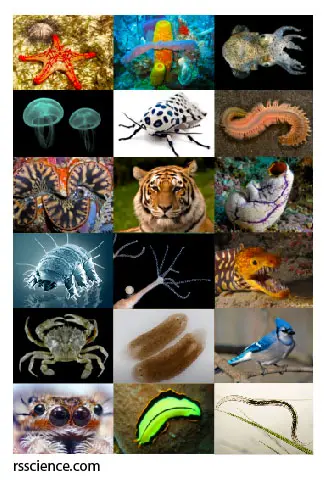
[In this image] Diversity of animals.
Could you classify them into each Phylum? The answer is at the end of this article.
Image source: modified from wiki
1. Phylum Chordata
Chordata is the group to which we belong. Members of Chordata share one characteristic – notochord, which is a rod running through the length of the body. Chordates are also bilaterally symmetric and possess a circulatory system.
In general, we divide animals into vertebrates (animals with a backbone) and invertebrates (animals that lack a backbone). In fact, this is a very rough classification. Vertebrata is only a subphylum under Chordata.
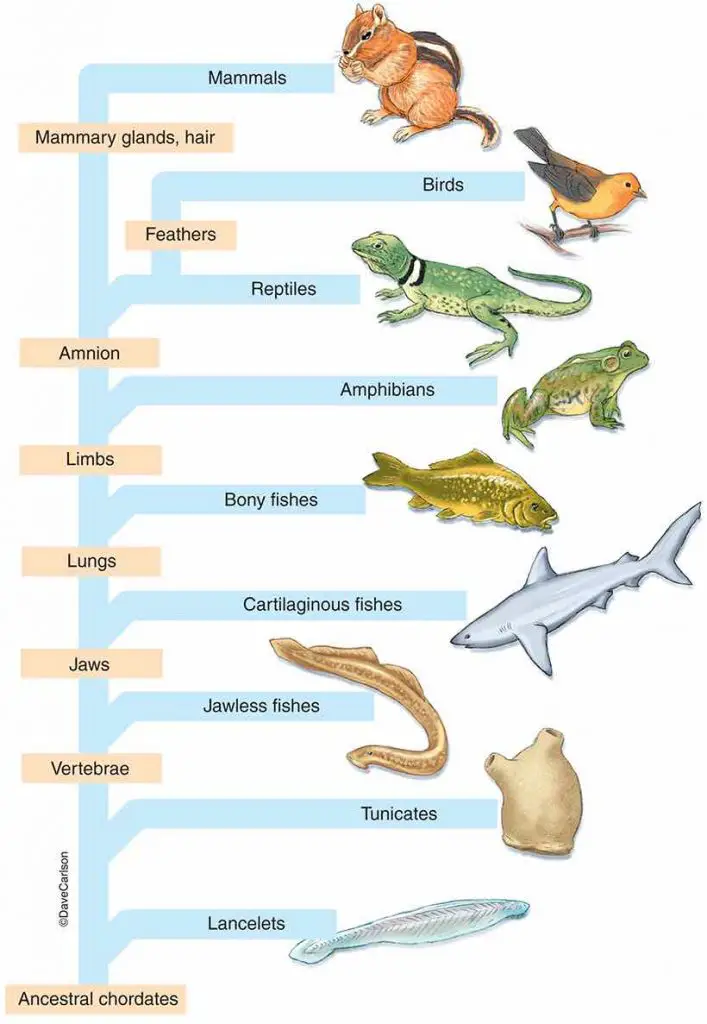
[In this image] Chordate family tree.
Photo credit: Carlson stock art
Vertebrata includes fish, amphibians, reptiles, birds, and mammals. Vertebrates’ notochords developed into hollow tubes of nervous tissues (the spinal cords) protected by backbones.

[In this image] Fossil skeleton of Diplodocus carnegii, showing an extreme example of the backbone that characterizes the vertebrates.
Image source: wiki
Sea squirts (also called Tunicates) get their nickname from their behavior to “squirt” out water when they are removed from the seawater. You may find them in tidepools or coral reefs. You may guess they are kinds of sponges or sea anemones. But however, sea squirts are invertebrate Chordate!
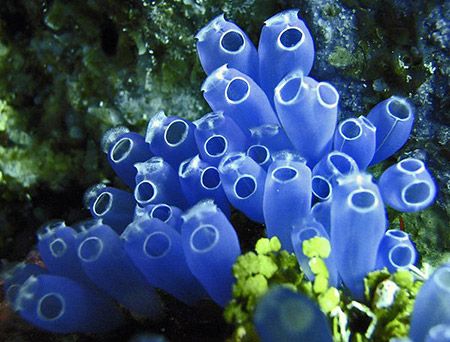
[In this image] The beautiful color of Colonial sea squirts.
Photo credit: Marinebio
2. Phylum Arthropoda
Arthropods are invertebrate animals having an exoskeleton, a segmented body, and paired jointed appendages (legs). Insects, spiders, scorpions, centipedes, mites, crabs, shrimps, daphnia, copepods, and trilobites (extinct) all belong to the enormous family of Arthropoda. Arthropoda owns the largest number of species among animals. They are very successful both on land, in water, and in the air.
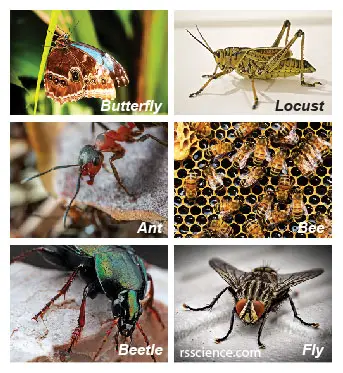
[In this image] Insects are the largest group within the phylum Arthropoda.
Insects are hexapods (six-legged) with a three-part body. Based on this definition, spiders (eight-legged), scorpions (8 legs), centipedes (30-354 legs), or millipedes (up to 750 legs) don’t belong to insects. Murine arthropods, like shrimps, crabs, or isopods, are not insects neither. In the pictures below, can you identify what they are and if they belong to insects?
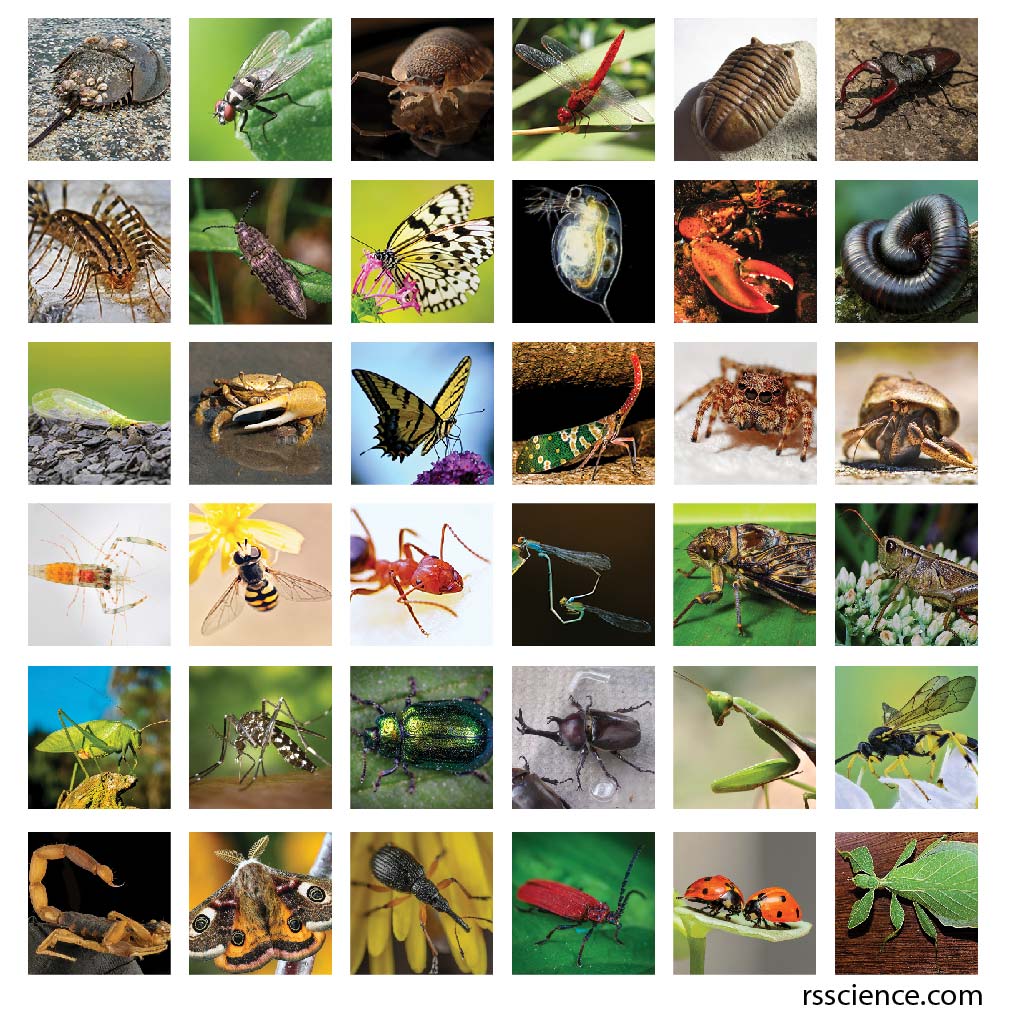
3. Phylum Mollusca
Mollusca is the second-largest phylum of invertebrate animals after the Arthropoda. Many familiar animals like clams, snails, slugs, octopi, and squid are members of Mollusca. They all have soft bodies, which typically have a “head” and a “foot” region. Often their bodies are covered by a hard exoskeleton, as in the shells of snails and clams, or the plates of chitons. Mollusks live in nearly all freshwater and marine environments, and some are even found on land.
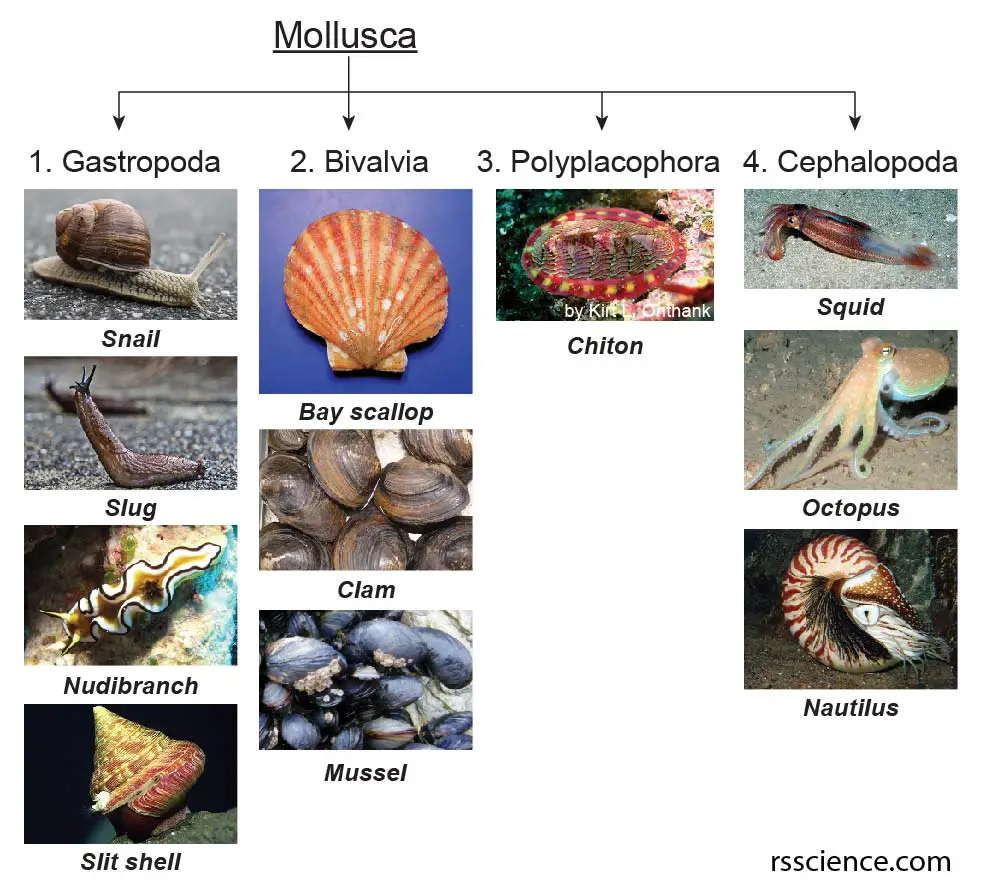
[In this image] There are four major groups within the phylum Mollusca: Gastropoda, Bivalvia, Polyplacophora, and Cephalopoda.
Photo source: NOAA.
There are four major groups within the phylum Mollusca:
1. Gastropoda is true snails and slugs. They represent the most diverse class within phylum Mollusca with 60,000 to 80,000 extant species in marine, freshwater, and on land.
2. Bivalvia is mollusks with hinged two-part shells. Examples include clams, oysters, mussels, and scallops.
3. Polyplacophora consists of chitons, snail-like mollusks with eight-part overlapping scale shells.
4. Cephalopoda is mollusks with large heads, large eyes, and grasping tentacles. Examples include octopus, squid, cuttlefish, and nautilus.
4. Phylum Cnidaria
Cnidaria is a phylum of animals with a shared feature: “using stinging cells to protect themselves or hunt for food”. They are predominantly marine species, but a smaller number of species (hydra) live in rivers and freshwater lakes. Examples of Cnidaria include jellyfish, sea anemones, corals, and hydra. You can see how diverse their body shapes are.
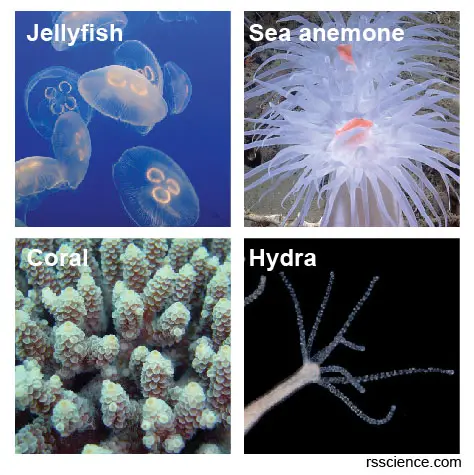
[In this image] Cnidarian are incredibly diverse in form. Examples of Cnidarian include jellyfishes, sea anemones, corals, and hydras.
Images credit: jellyfishes, sea anemones, and corals from NOAA, hydras from Stefan Siebert/Juliano Lab.
Learn more about Hydra:
5. Phylum Echinodermata
The name Echinodermata came from ancient Greek: echīnos means “hedgehog” and -derma means “skin”. As suggested by the name, the members of echinoderms are spiny-skinned. Examples include starfish, sea urchins, sand dollars, sea lilies, and sea cucumbers. They are all marine species.
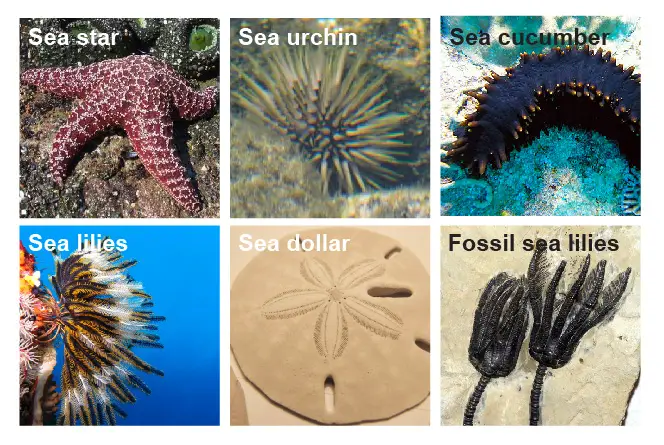
[In this image] Examples of Echinodermata, including sea stars, sea urchins, sea cucumbers, sea lilies, and sea dollars. They have radically symmetrical bodies with tough skins.
Photo source: wiki
6. Phylum Nematoda
The phylum Nematoda contains over 40,000 species inhabiting a broad range of environments. Many of them are parasitic worms. For example, roundworms (pinworms and ascariasis) in our bodies cause diarrhea and fever. Often, roundworm infections come from traveling to countries with poor sanitation and hygiene. Plants also have parasitic nematodes known as eelworms.
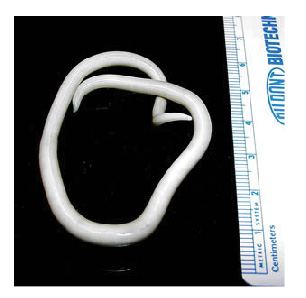
[In this image] This worm is an adult female Ascaris lumbricoides (also called Giant roundworm) about 15 cm in length. They can grow up to 40 cm and cause the disease ascariasis in humans. Other species of ascaris can infect other animals, including pigs, horses, and cows.
Image credit: CDC Division of Parasitic Diseases.

[In this image] A non-parasitic nematode called Caenorhabditis elegans (C. elegans).
It is an important model organism in the laboratory to help scientists understand gene functions and aging.
Photo source: wiki
Nematodes have successfully adapted to nearly every ecosystem: from marine to mountains, from the polar regions to the tropics. They are abundant in soils, even at great depths, 3.6 km below the surface of the Earth in gold mines in South Africa. Their numbers often exceed a million individuals per square meter and account for about 80% of all individual animals on Earth. They also represent 90% of all animals on the ocean floor. However, they are often overlooked due to their tiny sizes.
[In this video] A nematode under the microscope.
7. Phylum Annelida
The annelids are also known as ringed worms or segmented worms. They have successfully adapted to various ecologies – from the oceans to freshwater habitats as well as moist terrestrial environments.
Members of annelids include ragworms, earthworms, and leeches. They all have a body with multiple segments. Each segment has the same sets of organs. Many species have body walls to separate the segments. This body plan enables some of them to have remarkable regenerative ability. For instance, when an earthworm is cut into fragments, each piece can regrow into a new worm. Some annelids have bristles (parapodia) on their bodies to help the movement.

[In this image] Examples of annelids: earthworms, ragworms, and leeches.
Ragworms are marine species living in sand. Ragworms move through the sand by using the parapodia on the side of their body.
photo credit: national geographic, wiki
[In this video] See a collection of microscopic videos including Oligochaetes (a subclass of annelids) and many kinds of arthropods (daphnia, copepod, ostracod, amphipod, water mite, and mosquito larvae).
8. Phylum Platyhelminthes
The members of the phylum Platyhelminthes are known as flatworms. In ancestor Greek, “Platy” means flat, and “helminth” means worm. These “Alien” creatures have a simple, soft body without a body cavity, which limits their oxygen transport and must stay flat. They have a primitive brain and nervous system. The digestive cavity has only one opening for both ingestion (intake of nutrients) and egestion (removal of undigested wastes).
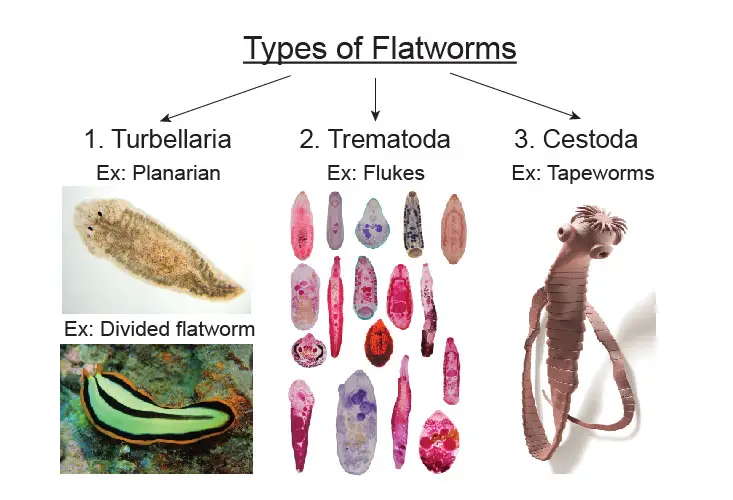
[In this image] Flatworms can be divided into three major categories: (1) Turbellaria: free-living flatworms, like Planaria (in freshwater) and Divided flatworms (in marine); (2) Trematoda: parasitic flukes that Infect internal organs of a host. Ex. Schistosoma fluke causes Schistosomiasis – fluke’s eggs clog blood vessels of patients; (3) Cestoda – parasitic tapeworms, such as pork and beef tapeworms, which have a snake-like long body and a head with suckers/hooks to attach to intestinal walls of a host.
Over half of all known flatworm species are parasitic, and some do enormous harm to humans and their livestock. Famous parasites that can cause human diseases are pork tapeworms, beef tapeworms, and flukes. However, many flatworm species are free-living in both fresh and saltwater. Some sea Turbellarians live in coral and are colorful and beautiful. Freshwater Turbellarians, called Planaria (singular: planarian), are commonly found in aqua tanks. You can find planaria demonstrating their incredible power of regeneration in laboratories or classrooms.
[In this video] See how a planarian move.
Learn more about Planarian and its power of regeneration.
9. Phylum Nematomorpha
Nematomorpha is sometimes called Gordiacea and is commonly known as horsehair worms or hairsnakes. The name Nematomorpha is because they look superficially similar to nematode worms, hence the name. The name “Gordian” stems from the legendary Gordian knot (impossible-to-untie knot). This relates to the fact that nematomorphs often tie themselves in knots while mating.
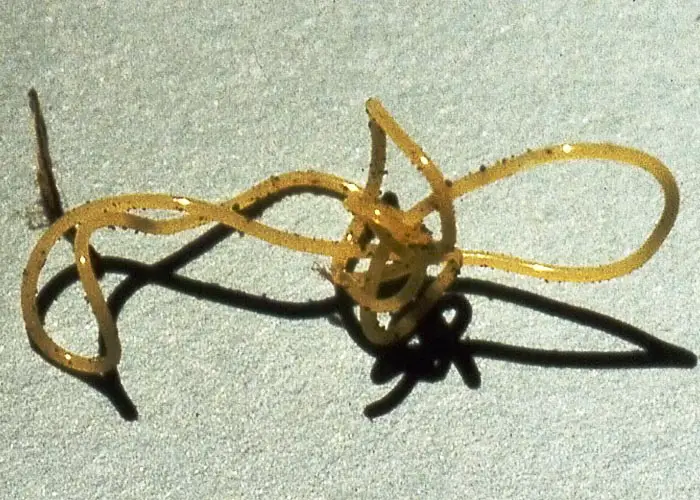
[In this image] A horsehair worm ties itself in knots.
Photo source: University of Wisconsin
Common sizes of nematomorphs range from 50 to 100 millimeters long and 1-3 millimeters in diameter. Some extreme cases can reach 2 meters long. The adult worms are free-living, but the larvae are parasitic on arthropods, such as beetles, cockroaches, and crustaceans. Although they are a relatively small group (only 351 freshwater species are known), I can say that they are the weirdest animals I ever seen.
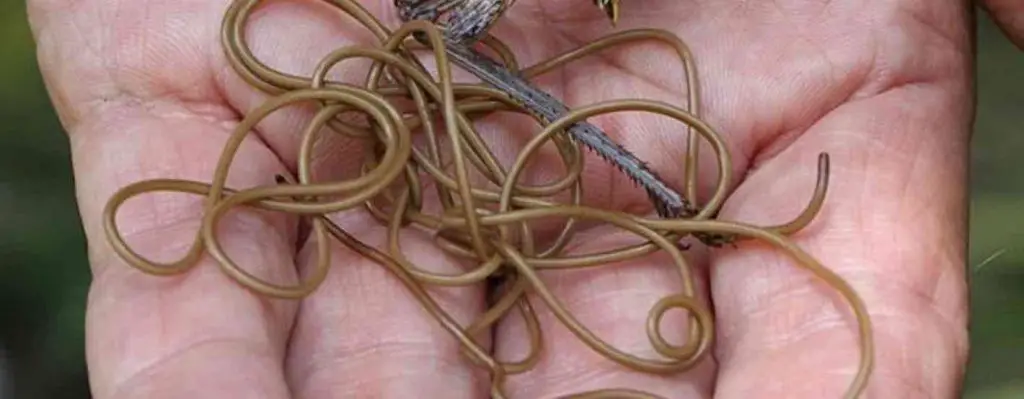
[In this image] A-half-meter long horsehair worm is coming out from a grasshopper.
Photo credit: The wildlife trusts
Horsehair worms need an arthropod host to complete their lifecycle, and they often kill their hosts. Horsehair worms are known for their terrifying ability in some species to highjack hosts’ nervous system, altering hosts’ behavior to seek out water actively. Once near water, the horsehair worm controls the host to jump into the water, drowning itself so the adult parasite can return to reproduce, completing the lifecycle. Fortunately, horsehair worms are harmless to vertebrates because they can’t parasitize people, livestock, pets, or birds.
10. Phylum Porifera
Sponges, the members of the phylum Porifera, are the simplest form of animals. They are multicellular organisms with only two thin layers of cells. Their bodies are full of pores and channels, allowing water to circulate through them.
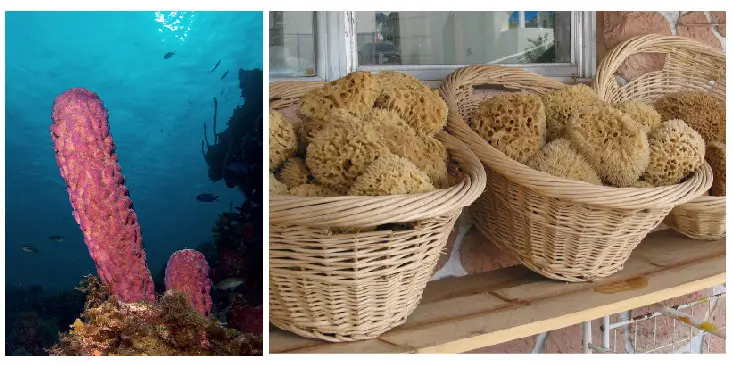
[In this image] (Left) A stove-pipe sponge. (Right) Some sponge species have soft, fibrous skeletons which can be used as bath products after being dried.
Photo source: wiki
Sponges don’t have specialized cells to form tissues or organs. As a result, sponges do not have nervous, digestive, or circulatory systems. Instead, they mostly rely on maintaining a constant water flow through their bodies to obtain food and oxygen and to remove waste.
You may wonder why sponges were classified as animals since you never see them moving. Sponges are similar to other animals in that they are multicellular, heterotrophic, lack cell walls, and produce sperm cells. In fact, sponge cells do move consistently within the whole body.
11. Phylum Rotifera
In the following three phyla, you will see three types of microscopic animals. They are often smaller than a half millimeter, so you need a microscope to find them.
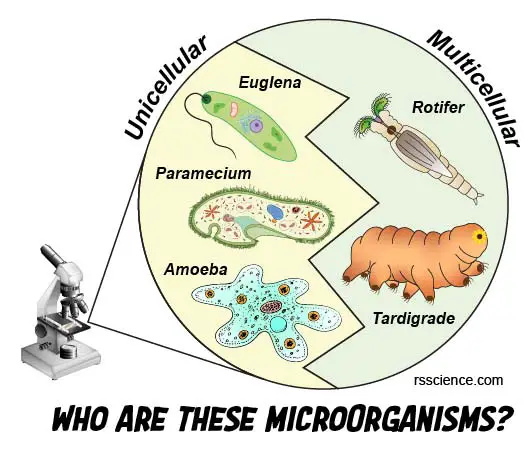
[In this image] Many microscopic organisms fall in the size of 100-500 μm. However, they can be totally different. Some microorganisms (like Euglena, Paramecium, and Amoeba) contain only one gigantic cell (single-celled) and are classified as protists. Others (like Rotifer, Tardigrade, and Gastrotrich), however, contain thousands of cells and belong to multicellular micro-animals.
[In this video] Rotifer’s rotating wheel is a corona with cilia around its mouth.
Rotifers got their name from the corona: a rotating, wheel-like structure covered with cilia at their heads. Rotifers occupy their own Phylum, Rotifera, and there are currently over 2,200 recognized species and 120 genera. Most rotifers are composed of an average of about 1,000 cells and 200-500 µm in length. Rotifers are small but fully functional organisms with several specialized organ systems. For example, they have a jawed mouth and complete digestive (including both mouth and anus), sensory, and reproductive organ systems. They are “small,” but not “simple!”
Learn more about rotifers below:
12. Phylum Tardigrada
You may not hear of Tardigrade, but you very likely know its nickname – Water bear. Tardigrades (mean “slow stepper”) look like chubby, microscopic bears walking slowly with eight short legs. A typical tardigrade is around 0.5 mm and contains 4,000 cells. Of no doubt, Tardigrades are the cutest tiny creatures you can find under a microscope.
[In this video] A tardigrade with a cute face.
Tardigrades were crowned the “Most Extreme” survivor on Earth. Some species of Tardigrade can survive in hot springs, in the deep ocean, under solid layers of ice, and even after exposure to deadly irradiation. We call them “extremophile.” They even survived after a space trip!
They can do so by turning into a dried-up dormant tun. The tun is resistant to extremely high temperature, pressure, irradiation, and freezing. Once encountering water, the tardigrades rehydrate and come back to life in a few minutes.
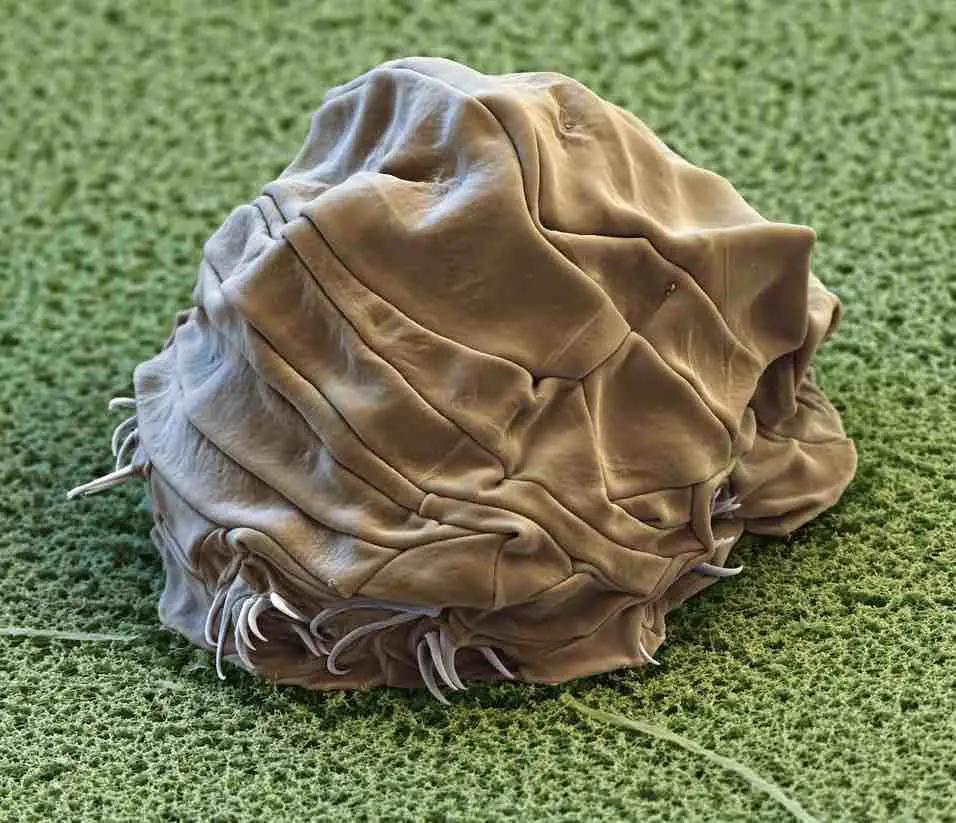
[In this image] A dehydrated tardigrade or tun.
Photo credit: Photo Science Library
Tardigrades are so unique that we have to give them their own phylum, called Tardigrada. There are about 1,300 known species in the phylum Tardigrada. The common features are eight-legged segmented micro-animals. Evolutionally speaking, tardigrades are closer to roundworms and insects; both are molting animals.
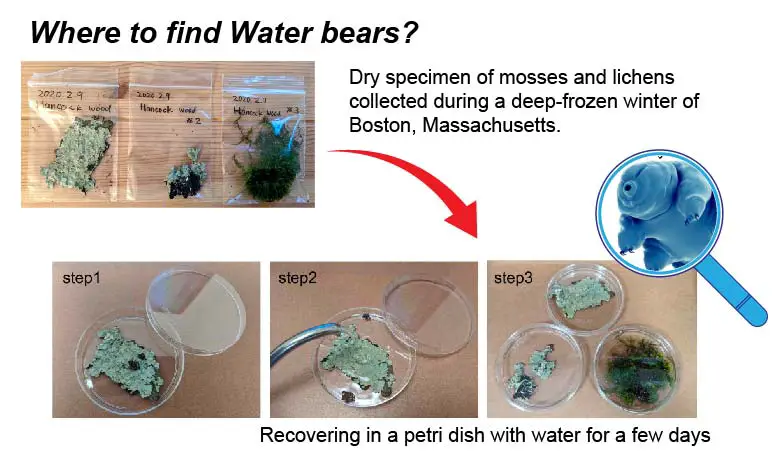
[In this image] You can find water bears under your microscope, too. See my note about finding rotifers and water bears recovered from a piece of frozen moss collected during the winter.
Learn more about tardigrades below:
13. Phylum Gastrotricha
Gastrotrichs, commonly referred to as hairybellies or hairybacks, are a group of microscopic (0.06 – 3 mm), worm-like animals with hairy bodies. Gastrotrichs live in both freshwater and marine environments and usually stay within detritus on the bottom.
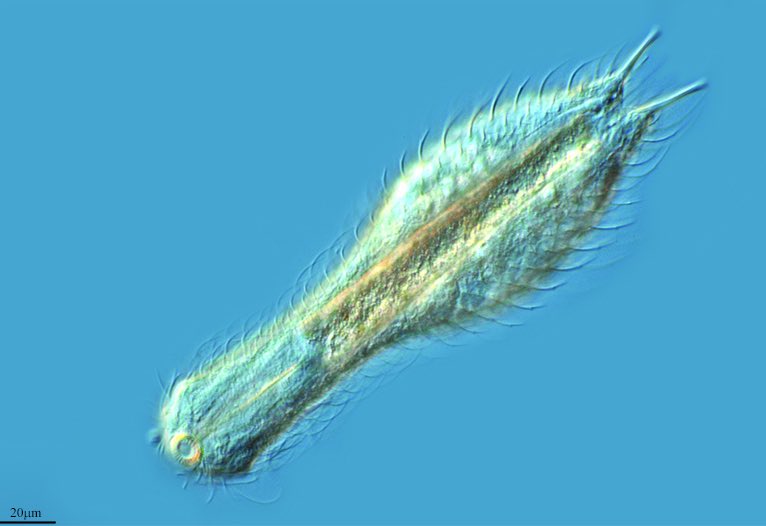
[In this image] This hairy microscopic creature calls Gastrotrich.
Photo source: eol
Gastrotrichs have a simple body plan with a head region, a brain and sensory organs, and a trunk with a simple gut and reproductive organs. They feed on detritus, sucking up organic particles with their muscular pharynx. Gastrotrichs’ lifespans are pretty short (only a few days).
[In this image] See a collection of microscopic videos including rotifers, tardigrades, hydra, planaria, nematodes, and gastrotrichs.
Part 4. The origins of Animals
Scientists believe that the origin of animals is monophyletic. This means that all animals can trace their descent back to a single common ancestor.
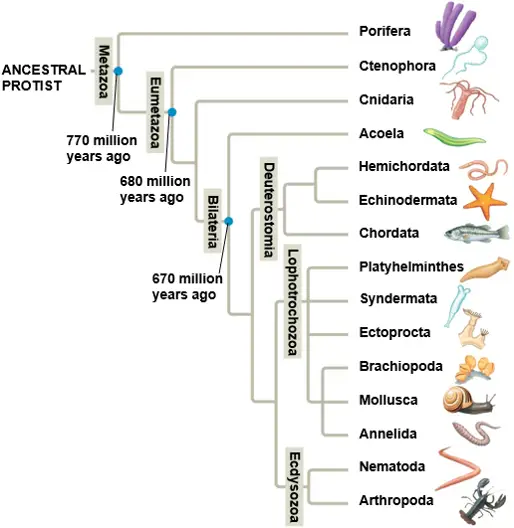
[In this image] The phylogenetic tree with the estimated branching time points along with the evolution of animals.
Image source: Biodiversity
The fossil record suggests that animals evolved 565 million years ago during the Ediacaran period of the latest Neoproterozoic era. A recent discovery of ancient sponge fossils pushed the oldest animals back 300 million years to 890-million-year-old. Based on genetic evidence, the origins of animals could be back to between 1 to 1.2 billion years ago.
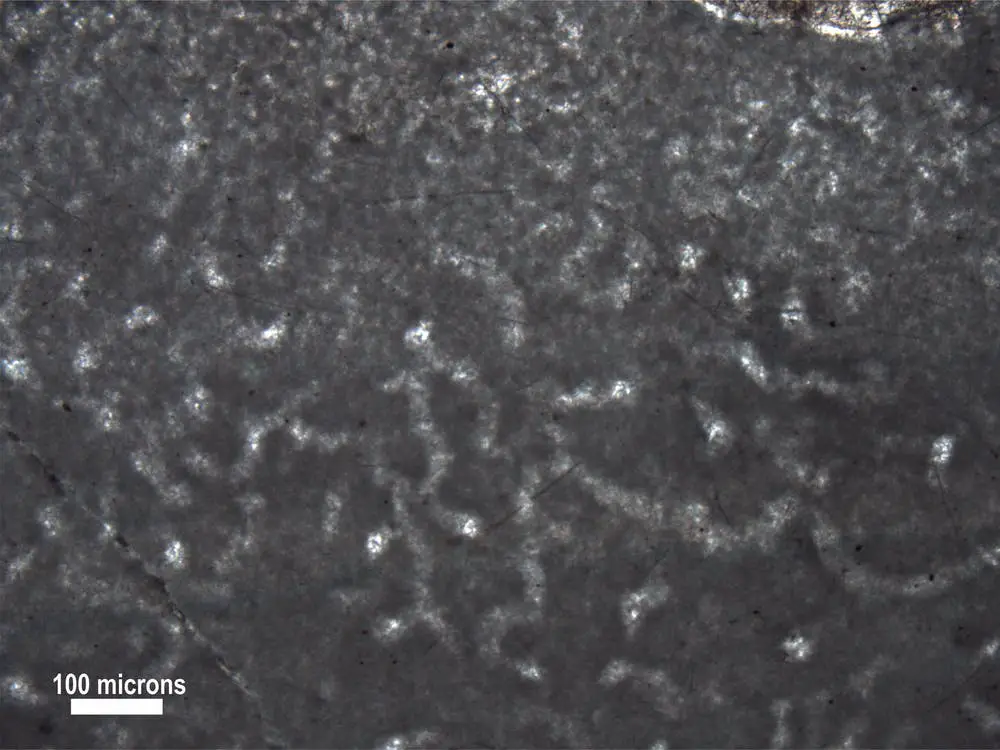
[In this image] This may be an 890-million-year-old sponge fossil.
Image source: The Conversation
By the beginning of the Cambrian period of the Paleozoic era, an explosive proliferation had established all the major phyla of animals. This incredible diversity of animal body plans and lifestyles arose in the relatively short period of 40 million years, between 565 and 525 million years ago. Today’s remarkably diverse animal forms are variations on the basic body plans that evolved during the Cambrian. However, many animal phyla that evolved during the Cambrian explosion are already extinct.
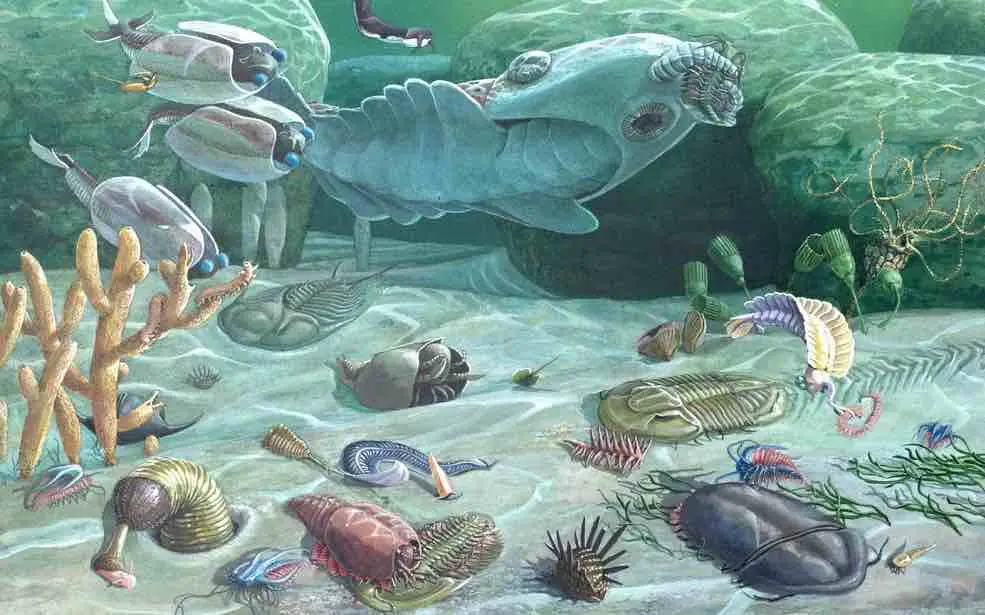
[In this image] The Cambrian explosion happened more than 500 million years ago. It was when most of the major animal phyla started to appear in the fossil records, a time of rapid expansion of different forms of life on Earth.
Image source: newdinosaurs
Summary
1. We (humans) are vertebrates under the phylum Chordate because we have spines.
2. Arthropoda owns the largest number of species among animals. Many of them are insects.
3. The ancestor of all animals might exist 1-1.2 billion years ago. However, it waited until the Cambrian explosion to develop the full diversity of animals.

